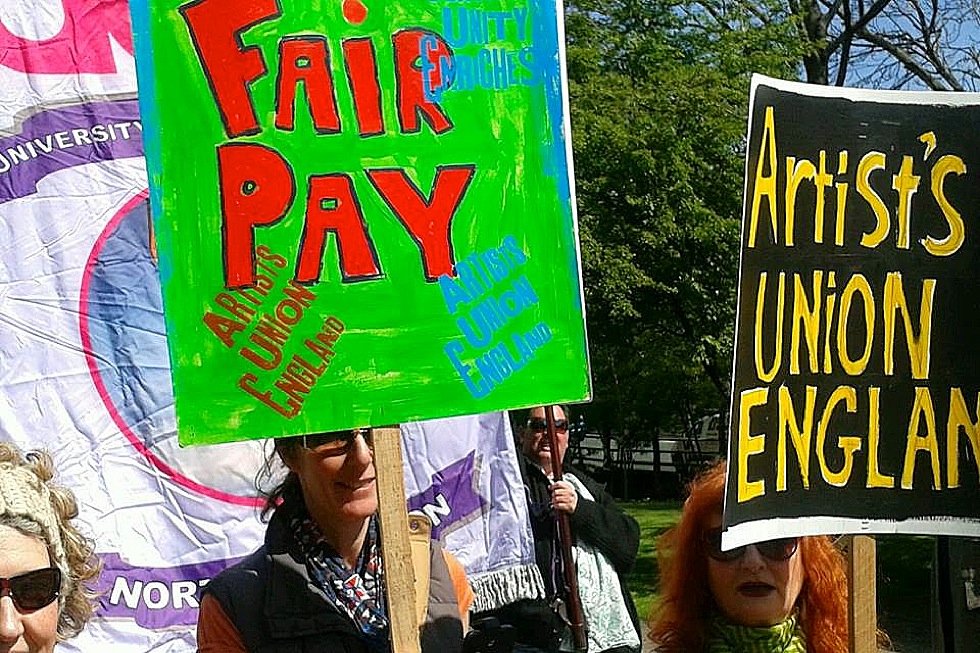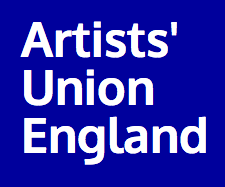Why I Joined The New Artists’ Union

There hasn’t been a trade union for artists in England since 1984. Launched this year, Artists’ Union England is promising to address issues around working conditions and pay in the art world. Here, member Richard Whitby explains what unions can do for artists and why we should care…
There are some obvious contestations to the idea of an artists’ union. Can individualistic and competitive artists work together? The most visible examples of contemporary art in this country often seem to manifest the most grotesque features of unfettered capitalism; others can end up rendering political engagement an aesthetic choice rather than an intrinsic part of life as an artist. Artists are thought of as middle or upper class; trade unions often as working class institutions. Can artists strike, and if they did, who would care? Are trade unions even relevant institutions anymore; aren’t they a thing of the past, inextricably linked to ‘old Labour’ and fundamentally undermined, forever, by Margaret Thatcher in the 1980s?
A trade union can be defined as ‘a continuous association of wage-earners for the purpose of maintaining or improving the conditions of their working lives’ (Sidney and Beatrice Webb, History of Trade Unionism, 1920). Artists certainly do not work in a traditional mode of employment; few of us would describe ourselves as earning a ‘wage’, for example. The vast majority of artists’ work is self-employed, with no ‘shop-floor’, and no easily identifiable ‘bosses’. In my experience, both at art school and since, there is a bashfulness from artists in talking about employment. I suspect this is symptomatic of a culture in which ‘success’ means making a living solely from one’s art, plus the embarrassment of a continuing association of art with bourgeois privilege rather than wage labour.
To use my own practice as an example, I sporadically make some money from it, supplementing that with other types of work in what is often described as a ‘portfolio career’ (which for me most often means an unpredictable and fractured working life, despite the slick, stock-market connotations of this term).
There are unions already in existence that serve artists working in certain capacities. The Broadcasting, Entertainment, Cinematograph and Theatre Union (BECTU), for example, cover many front-of-house workers; the University and College Union (UCU) look after academics, lecturers, trainers, researchers and academic-related staff; and Artists’ Newsletter (a-n) has been fulfilling some of the functions of an artists’ union in its absence, offering very useful insurance deals and guidance on fair pay.
Artists’ Union England (AUE) is, for now, principally based upon sharing information and offering solidarity. Set up early this year by 13 people wanting to address ‘an evident lack of accountable, democratic, independent representation for artists’, the union now has over 500 members, with only word of mouth to advertise it. The union’s stated aims include ‘to represent artists at strategic decision-making levels and positively influence the role artists play within society […] to challenge the economic inequalities in the art world and to negotiate fair pay and better working conditions for artists […] to work with other unions, arts organisations, government bodies and cultural institutions whilst remaining both independent and transparent’ (artistsunionengland.org.uk, November 2014).
At the moment, there is an annual subscription of £30 (rather than a percentage of earnings, like many other unions), although there will likely be a reduced student membership introduced next year. The union is currently run by an elected executive committee of nine people from across England, and all work carried out within the union is undertaken on a voluntary basis.

Within AUE, several working groups exist with specific tasks suggested by members. Currently, these include campaigning for recognition by Arts Council England, and producing a set of guidelines on rates of pay and fundraising for the union’s certificate of independence (an expensive impediment to any union’s founding, introduced by Thatcher and still an essential part of a new union’s existence). Members are also preparing to meet Culture Minister Ed Vaizey, and working on informing members of the impact of the forthcoming ‘universal tax credit’ (which replaces, amongst others, the working tax credit and is likely to have a detrimental effect on many artists’ incomes).
One step towards wresting the idea of artists’ labour away from privilege and towards something more like general employment is representation in the workplace, wherever that might be (studio, gallery, arts centre, hospital). As the union grows, it will be able to offer insurance, as the Scottish Artists’ Union already does, and legal representation – eventually perhaps even pension schemes and debt collection services.
A union is, almost by definition, not a radical gesture; it is a structure with which to broker better deals for workers, most usually on matters of pay and conditions. Soon, the AUE will become a member of the General Federation of Trade Unions, and be supported by a network of other smaller unions. By being involved in the institution of trade unionism, artists will able to stand with other campaigning groups, not only as part of short-lived, issue-based activist groups, but in solidarity with organised workers.
The arts sector is a small one, run by highly educated people, often extremely politically aware and passionate about what they do. It is also often a terrible place to work. The palpably extreme level of competition and rush to ‘make it’ I think leads easily to feelings of failure, desperation and isolation in artists. The scramble for the few jobs and opportunities that exist for the ever-increasing number of graduates creates a pliable workforce, susceptible to exploitation in the form of low wages, disadvantageous contracts and unpaid work. A culture of frantic activity also sometimes convinces people (myself included) that they do not have time for political engagement – every spare minute out of paid work should be invested in the studio. It needn’t be this way.
Organising ourselves is the first step to changing this; to share experiences and information, in a way that will particularly benefit artists entering the ‘job-market’ from college. The art world is full of opportunities for artists to meet around artwork; this union is a chance to convene as workers. Rather than trailblazing neoliberal-style self-exploitation, the small institutions of the art-world and artists’ own practices should be flexible enough to do better, and to look after the people they employ.
It could be argued that although artists do not have traditional jobs, they in fact occupy a mode of employment that is becoming mainstream; more and more workers, especially low-paid ones, have ‘portfolio careers’, even if we are not used to calling them such. A union promotes and enacts the principle of solidarity between artists, and by extension all workers, against the tide of neoliberalised employment relations, where atomised workers lose more and more rights.
I have been a member of Artists’ Union England since July 2014, and the conversations I have had since, and the work I have done as part of it, have not only felt necessary, but have imbued a sense of hope in me that is all too rare in political culture in England today. We have to start somewhere, and we need to start together.
Richard Whitby
A version of this article was originally commissioned for FuelRCA, the Royal College of Art’s professional development service
More on the AUE here, and on Twitter @ArtistsUnionE
Image courtesy 36 Lime Street





